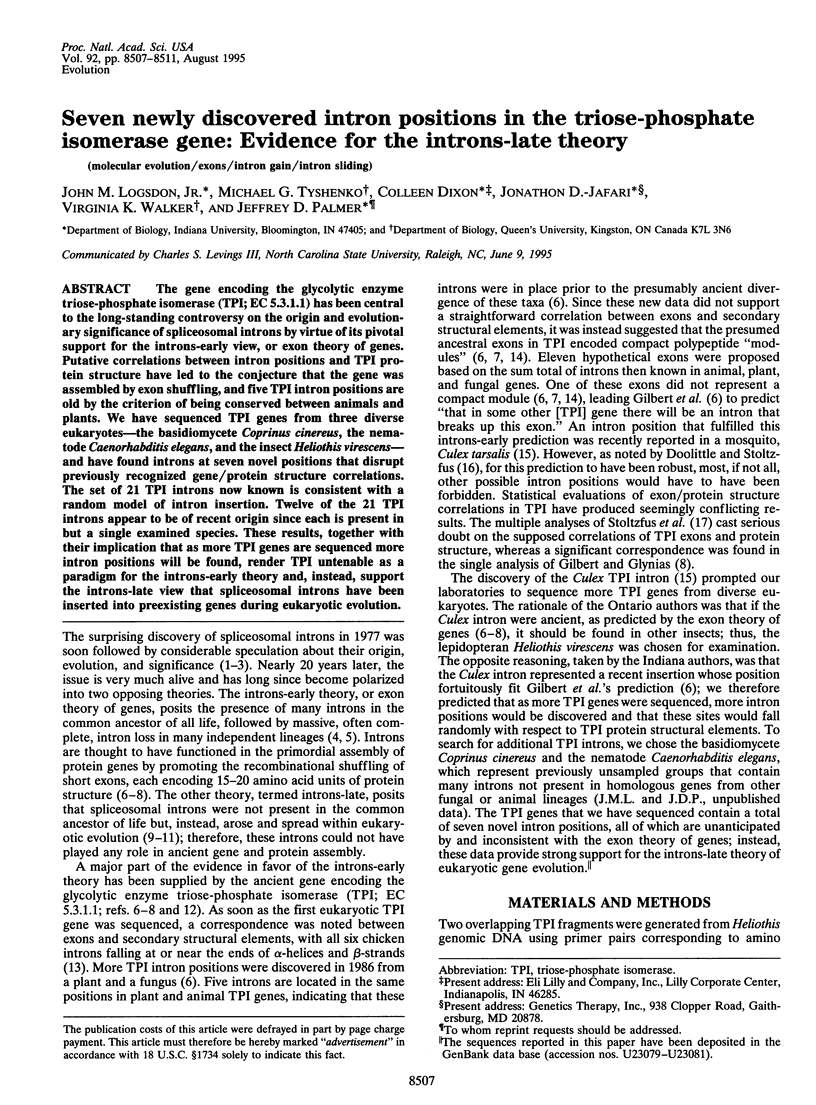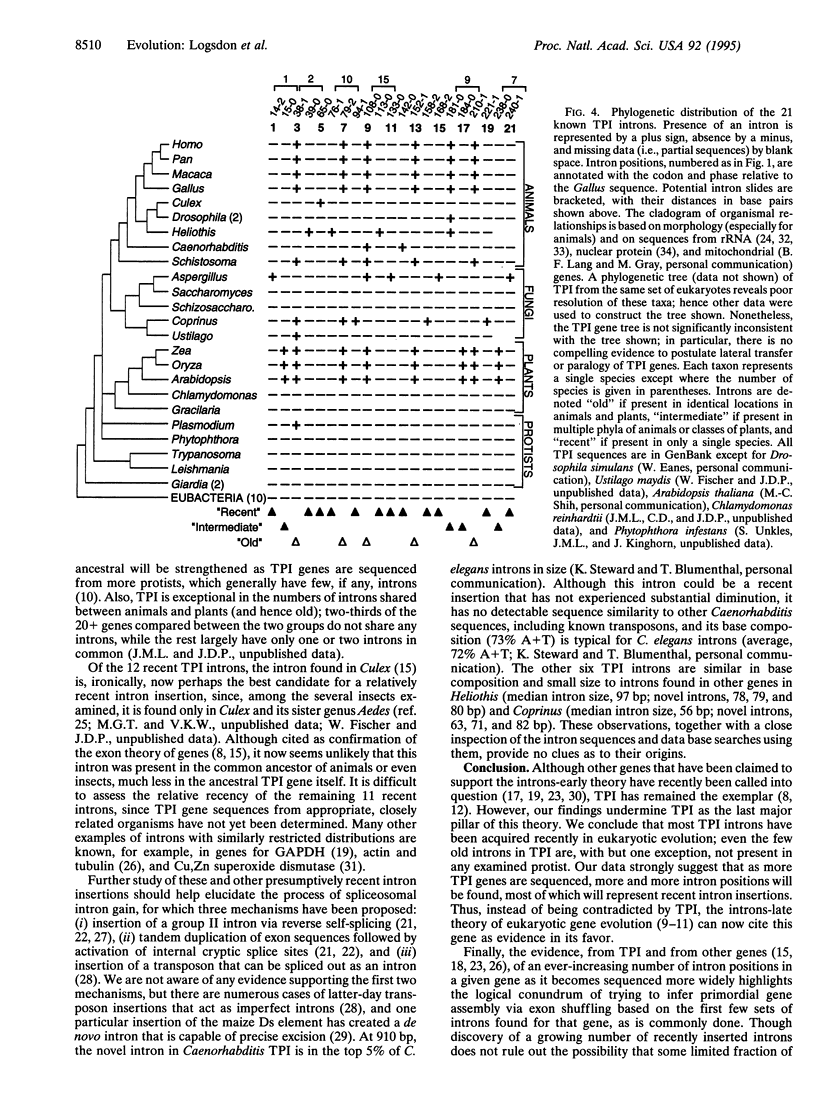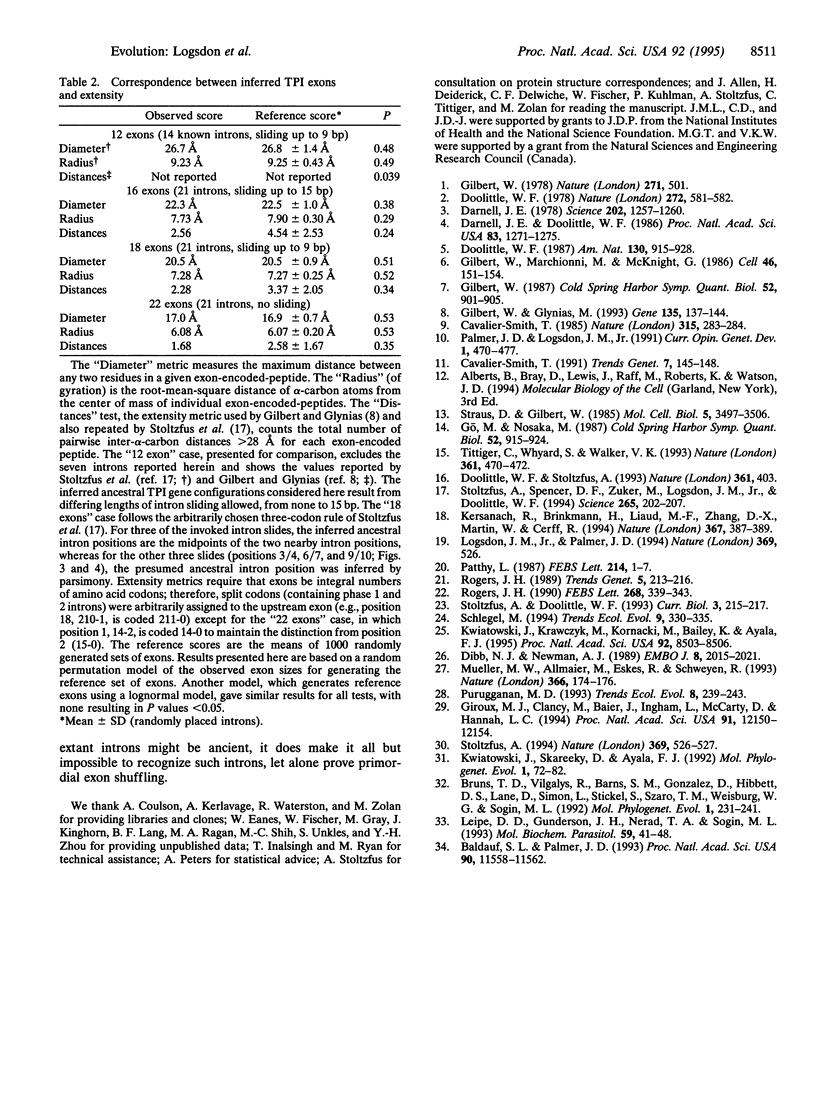Abstract
The gene encoding the glycolytic enzyme triose-phosphate isomerase (TPI; EC 5.3.1.1) has been central to the long-standing controversy on the origin and evolutionary significance of spliceosomal introns by virtue of its pivotal support for the introns-early view, or exon theory of genes. Putative correlations between intron positions and TPI protein structure have led to the conjecture that the gene was assembled by exon shuffling, and five TPI intron positions are old by the criterion of being conserved between animals and plants. We have sequenced TPI genes from three diverse eukaryotes--the basidiomycete Coprinus cinereus, the nematode Caenorhabditis elegans, and the insect Heliothis virescens--and have found introns at seven novel positions that disrupt previously recognized gene/protein structure correlations. The set of 21 TPI introns now known is consistent with a random model of intron insertion. Twelve of the 21 TPI introns appear to be of recent origin since each is present in but a single examined species. These results, together with their implication that as more TPI genes are sequenced more intron positions will be found, render TPI untenable as a paradigm for the introns-early theory and, instead, support the introns-late view that spliceosomal introns have been inserted into preexisting genes during eukaryotic evolution.
Full text
PDF




Images in this article
Selected References
These references are in PubMed. This may not be the complete list of references from this article.
- Baldauf S. L., Palmer J. D. Animals and fungi are each other's closest relatives: congruent evidence from multiple proteins. Proc Natl Acad Sci U S A. 1993 Dec 15;90(24):11558–11562. doi: 10.1073/pnas.90.24.11558. [DOI] [PMC free article] [PubMed] [Google Scholar]
- Bruns T. D., Vilgalys R., Barns S. M., Gonzalez D., Hibbett D. S., Lane D. J., Simon L., Stickel S., Szaro T. M., Weisburg W. G. Evolutionary relationships within the fungi: analyses of nuclear small subunit rRNA sequences. Mol Phylogenet Evol. 1992 Sep;1(3):231–241. doi: 10.1016/1055-7903(92)90020-h. [DOI] [PubMed] [Google Scholar]
- Cavalier-Smith T. Intron phylogeny: a new hypothesis. Trends Genet. 1991 May;7(5):145–148. [PubMed] [Google Scholar]
- Cavalier-Smith T. Selfish DNA and the origin of introns. Nature. 1985 May 23;315(6017):283–284. doi: 10.1038/315283b0. [DOI] [PubMed] [Google Scholar]
- Darnell J. E., Doolittle W. F. Speculations on the early course of evolution. Proc Natl Acad Sci U S A. 1986 Mar;83(5):1271–1275. doi: 10.1073/pnas.83.5.1271. [DOI] [PMC free article] [PubMed] [Google Scholar]
- Darnell J. E., Jr Implications of RNA-RNA splicing in evolution of eukaryotic cells. Science. 1978 Dec 22;202(4374):1257–1260. doi: 10.1126/science.364651. [DOI] [PubMed] [Google Scholar]
- Dibb N. J., Newman A. J. Evidence that introns arose at proto-splice sites. EMBO J. 1989 Jul;8(7):2015–2021. doi: 10.1002/j.1460-2075.1989.tb03609.x. [DOI] [PMC free article] [PubMed] [Google Scholar]
- Doolittle W. F., Stoltzfus A. Molecular evolution. Genes-in-pieces revisited. Nature. 1993 Feb 4;361(6411):403–403. doi: 10.1038/361403a0. [DOI] [PubMed] [Google Scholar]
- Gilbert W., Glynias M. On the ancient nature of introns. Gene. 1993 Dec 15;135(1-2):137–144. doi: 10.1016/0378-1119(93)90058-b. [DOI] [PubMed] [Google Scholar]
- Gilbert W., Marchionni M., McKnight G. On the antiquity of introns. Cell. 1986 Jul 18;46(2):151–153. doi: 10.1016/0092-8674(86)90730-0. [DOI] [PubMed] [Google Scholar]
- Gilbert W. The exon theory of genes. Cold Spring Harb Symp Quant Biol. 1987;52:901–905. doi: 10.1101/sqb.1987.052.01.098. [DOI] [PubMed] [Google Scholar]
- Gilbert W. Why genes in pieces? Nature. 1978 Feb 9;271(5645):501–501. doi: 10.1038/271501a0. [DOI] [PubMed] [Google Scholar]
- Giroux M. J., Clancy M., Baier J., Ingham L., McCarty D., Hannah L. C. De novo synthesis of an intron by the maize transposable element Dissociation. Proc Natl Acad Sci U S A. 1994 Dec 6;91(25):12150–12154. doi: 10.1073/pnas.91.25.12150. [DOI] [PMC free article] [PubMed] [Google Scholar]
- Go M., Nosaka M. Protein architecture and the origin of introns. Cold Spring Harb Symp Quant Biol. 1987;52:915–924. doi: 10.1101/sqb.1987.052.01.100. [DOI] [PubMed] [Google Scholar]
- Kersanach R., Brinkmann H., Liaud M. F., Zhang D. X., Martin W., Cerff R. Five identical intron positions in ancient duplicated genes of eubacterial origin. Nature. 1994 Jan 27;367(6461):387–389. doi: 10.1038/367387a0. [DOI] [PubMed] [Google Scholar]
- Kwiatowski J., Krawczyk M., Kornacki M., Bailey K., Ayala F. J. Evidence against the exon theory of genes derived from the triose-phosphate isomerase gene. Proc Natl Acad Sci U S A. 1995 Aug 29;92(18):8503–8506. doi: 10.1073/pnas.92.18.8503. [DOI] [PMC free article] [PubMed] [Google Scholar]
- Kwiatowski J., Skarecky D., Ayala F. J. Structure and sequence of the Cu,Zn Sod gene in the Mediterranean fruit fly, Ceratitis capitata: intron insertion/deletion and evolution of the gene. Mol Phylogenet Evol. 1992 Mar;1(1):72–82. doi: 10.1016/1055-7903(92)90037-h. [DOI] [PubMed] [Google Scholar]
- Leipe D. D., Gunderson J. H., Nerad T. A., Sogin M. L. Small subunit ribosomal RNA+ of Hexamita inflata and the quest for the first branch in the eukaryotic tree. Mol Biochem Parasitol. 1993 May;59(1):41–48. doi: 10.1016/0166-6851(93)90005-i. [DOI] [PubMed] [Google Scholar]
- Logsdon J. M., Jr, Palmer J. D. Origin of introns--early or late? Nature. 1994 Jun 16;369(6481):526–528. doi: 10.1038/369526a0. [DOI] [PubMed] [Google Scholar]
- Mueller M. W., Allmaier M., Eskes R., Schweyen R. J. Transposition of group II intron aI1 in yeast and invasion of mitochondrial genes at new locations. Nature. 1993 Nov 11;366(6451):174–176. doi: 10.1038/366174a0. [DOI] [PubMed] [Google Scholar]
- Palmer J. D., Logsdon J. M., Jr The recent origins of introns. Curr Opin Genet Dev. 1991 Dec;1(4):470–477. doi: 10.1016/s0959-437x(05)80194-7. [DOI] [PubMed] [Google Scholar]
- Patthy L. Intron-dependent evolution: preferred types of exons and introns. FEBS Lett. 1987 Apr 6;214(1):1–7. doi: 10.1016/0014-5793(87)80002-9. [DOI] [PubMed] [Google Scholar]
- Rogers J. H. How were introns inserted into nuclear genes? Trends Genet. 1989 Jul;5(7):213–216. doi: 10.1016/0168-9525(89)90084-x. [DOI] [PubMed] [Google Scholar]
- Rogers J. H. The role of introns in evolution. FEBS Lett. 1990 Aug 1;268(2):339–343. doi: 10.1016/0014-5793(90)81282-s. [DOI] [PubMed] [Google Scholar]
- Stoltzfus A., Ford Doolittle W. Molecular evolution: slippery introns and globin gene evolution. Curr Biol. 1993 Apr 1;3(4):215–217. doi: 10.1016/0960-9822(93)90336-m. [DOI] [PubMed] [Google Scholar]
- Stoltzfus A. Origin of introns--early or late. Nature. 1994 Jun 16;369(6481):526–528. doi: 10.1038/369526b0. [DOI] [PubMed] [Google Scholar]
- Stoltzfus A., Spencer D. F., Zuker M., Logsdon J. M., Jr, Doolittle W. F. Testing the exon theory of genes: the evidence from protein structure. Science. 1994 Jul 8;265(5169):202–207. doi: 10.1126/science.8023140. [DOI] [PubMed] [Google Scholar]
- Straus D., Gilbert W. Genetic engineering in the Precambrian: structure of the chicken triosephosphate isomerase gene. Mol Cell Biol. 1985 Dec;5(12):3497–3506. doi: 10.1128/mcb.5.12.3497. [DOI] [PMC free article] [PubMed] [Google Scholar]
- Tittiger C., Whyard S., Walker V. K. A novel intron site in the triosephosphate isomerase gene from the mosquito Culex tarsalis. Nature. 1993 Feb 4;361(6411):470–472. doi: 10.1038/361470a0. [DOI] [PubMed] [Google Scholar]




